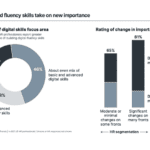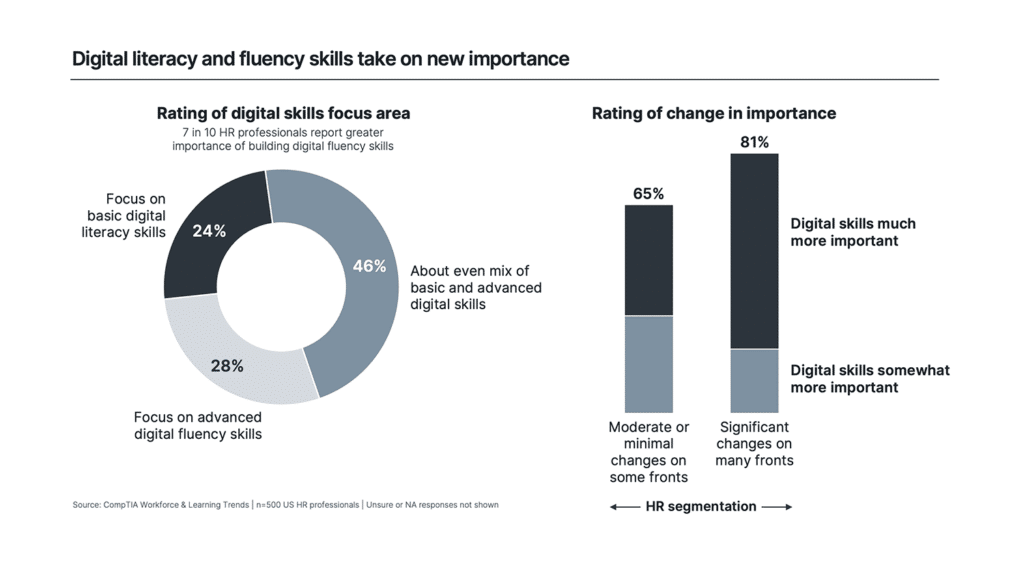The dearth of women’s leadership opportunities in the tech industry is nothing new. But what is—relatively—new is the advent of artificial intelligence, and it can be an important equalizer in the effort to advance women in tech, says Skillsoft Chief People Officer Ciara Harrington.
The digital learning provider recently released a report on the state of women’s representation in tech—finding that more than 37% of women surveyed are looking for a new job. The reasons why? Management and compensation were big factors, as was a perceived lack of growth opportunities. In particular, women are craving more training around emerging tech like generative AI.
As generative AI becomes baked into Skillsoft’s customer solutions, the organization is also having its employees “experiment like crazy” with it, Harrington says. Gen AI training can be an important differentiator for organizations looking to invest equally in all employees—an aim that Skillsoft also pursues through two robust internal women’s groups and the recent expansion of paid parental leave to 12 weeks off, on top of short-term disability access for birthing parents, among other initiatives, she adds.
Harrington—who joined Skillsoft in 2022 after HR leadership roles at Syngenta, Dell, NBCUniversal and more in locations around the globe, as well as extensive consulting experience—shared with Human Resource Executive how Skillsoft envisions the potential of generative AI for its business and people strategy.
HRE: Especially given Skillsoft’s tech focus, how are you incorporating AI into your HR strategy?

Harrington: When generative AI came out, companies took two approaches. Some companies said [to employees], “We don’t want you using this product. We don’t know enough about it.” As a learning organization, we felt the opposite. We said, “We need to start to understand this product, we need to learn it, we need to know how it works. We need to understand how it is going to change the way we work and how we are going to think about talent, roles and jobs in the future.”
We very quickly got a safe, walled-in instance of an open AI that we were able to use internally, and we pushed it to all employees. We are, of course, a compliance company, so ethical use of this was extremely important. Employees had to review and sign a policy as well as take a certain amount of trainings before we would activate their login to the site. These trainings were also very clear on roles and responsibilities. Generative AI is a tool like Google is a tool; what you send in an email to somebody, that is a reflection of you. We don’t want to hear, “Well, I didn’t write that, generative AI wrote it.” We were very clear from the beginning: It is a tool to help you do your job.
Since then, we’ve created an AI Council and we have just been experimenting like crazy, which has been super fun. As a group, we talk about the different things people are doing, and we brainstorm on ways that we could do those within our organization. All of us as leaders are being held accountable: getting ourselves 5% more productive using generative AI and reporting back on how we’re going to do that—as well as trying to figure out the other tasks people are going to do with their time.
We’re constantly trying to stay on the front end of the technology. I think one of the things that’s challenging is when you roll it out, first, everybody’s excited about it, and then slowly, it starts to level off. So, we’re bringing it into town halls, having people demonstrate and showcase what they’re doing with it, and we’re trying to keep the energy and the excitement alive.
Read more Insights from a CHRO here.
HRE: Can you tell me more about your AI Council?
Harrington: We have our head of strategy as a general expert, and then every single department had to allocate somebody to be the go-to person for generative AI, and those people are getting additional training and education on the more detailed nuances of how the system works. There’s also compliance people on the Council, and there’s HR representation. If someone comes up with an idea that was like, “Hey, let’s put everyone’s pay into Open AI,” someone could be like, “Well, no, maybe that’s not a good idea.” There’s anybody who’s needed to do a check and balance as well as the representative from each organization who’s responsible for driving their AI strategy and coming back to share the ideas with their teams.
HRE: Given the focus on learning within Skillsoft, how do you prioritize your own learning and development?
Harrington: I am really big on whatever rules I apply to the company, I first apply to myself and then my team. When it comes to generative AI training, my organization will often pilot a lot of what we’re going to roll out. I’ll roll that out in HR first, for three or four weeks in advance—pressure-test it, make sure everything’s working correctly—and then push it to the rest of the organization.
It’s important to me that anything I’m pushing to the organization is something that I have done myself. When I stand up in front of the whole organization in a town hall and say, “We’re going to have all of you take this training,” I not only want to be able to say I did it, but I also want to be able to explain it. In general, I apply that logic to all of our programs. I don’t roll out an EAP program to my organization until I have first called the line myself and had a conversation.
HRE: How has your total rewards experience influenced your current focus and approach to HR leadership?
Harrington: I get asked this question a lot because I have not had the standard path of a chief people officer. I’m quite good at math, which is how I ended up in total rewards in the first place. I’m analytical, I enjoy data, and I enjoy using it to make decisions or learn and understand about behaviors. And I think traditionally, in a lot of the other areas of HR, it’s more difficult to do that.
What generative AI has actually done is open up this world where qualitative data is now super easy to analyze. An example: our previous culture survey results. It’s an amazing process we go through. We have 2,500 people and 100 pages of comments—literally in a PDF document. Before generative AI, I would hand these out to people on my team. They would have to sit down and read them and summarize them.
This year, we put them into our internal generative AI instance and we were able to ask it: What are the three things the HR organization needs to work on? What are the three things it’s doing well? What are three development areas that the HR organization should be looking at? What actions would you recommend I take after reading all of these comments?
[Generative AI has] made a world where this data is now much more easy to analyze and draw conclusions from. Now to be really clear, given where generative AI is, we are still doing both: We run it through the large language model but we also read the comments; this is part of our learning.
See also: Why a more strategic approach is needed to navigate AI in HR
HRE: How do you think technologies like generative AI are reshaping the HR role?
Harrington: Data and analytics in HR have taken on a much bigger role, and I also think the role of the chief people officer has gotten more strategic; in the last number of years, it’s getting more influence with the CEO and the executive membership team. A large part of being able to influence a group of executives or board members is through data and analytics. It’s through demonstrating, “Here’s a problem I have discovered. Here’s what I’m going to do to solve it. And then along the way, here’s how I can show you that I’m actually making progress toward that goal.” It lends a lot more credibility to what my organization does because we can demonstrate the improvement and we can actually show the changes in behavior. It brings a level of analytical problem-solving to the traditionally softer areas of the HR organization.
HRE: What or who—outside of work—most influences who you are as an HR leader?
Harrington: I’ve wanted to be an HR leader since I was a really small child. I have just always believed in the power of people and talent. And this is why it’s been really exciting for me in the last decade to really see the role of the CHRO get elevated in the way that it has. I was influenced very early on by just my interest in people and talent and how they drive business results.
Being a chief people officer is absolutely one of my jobs but my main job is definitely being a mom to my two children. I have two small boys—the juggle is real. Anyone with small children can understand this: When I finish work at 6 o’clock, I’m not going to kick back on the sofa with a glass of wine and television show, right? I am straight into minding them, getting them dinner, playing with them, preparing for the next day. And then it’s straight into bed and up first thing in the morning. I think that mode of going from Mom to Chief People Officer … there’s a way in which you organize your life and you have to be agile and able to adjust and roll with the punches. And being a mom of young kids actually can help you cope with the unexpected, the challenges that come up. They have two very different personalities, they’re constantly in conflict and I’m constantly resolving conflict. It creates an innate calmness in parents, and you bring that to your role.
HRE: How do you think being a parent has influenced your perspective on women in leadership?
Harrington: I’m a mom of boys but I always envisioned myself with a girl. I was a big feminist growing up, and I envisioned myself having another female who was going to be this amazing, strong female. But I’ve come to learn that actually being a mom of boys is actually more powerful. They’re growing up in a world where their mom has the bigger job, their mom travels and they understand all of this—and I think it’s things like this that can actually drive change. My sons will be in the workplace in 10, 12 years and they won’t be thinking about whether someone [in leadership is] male or female because they just grew up in a world where it was equal from the beginning. This isn’t something that even ever occurs to them. And that drives me on a day-to-day basis.
One of the reasons I chose this space is I really want to be an advocate for females, but especially for moms who have young children. I really like to lead with an attitude of family first. You have a sick kid at home, and there is nothing you can do about it, so me [as an employer] being annoyed with you is only going to make it worse. I like to try to drive that understanding in the organization. If we want parents in the workplace, we need to be able to live in a world where these things become normal and are not things that people are judged on. Anybody who’s struggling, every single team member, has some personal situation they’re dealing with, and I think it’s so important that organizations give them the space they need.
The post How Skillsoft is encouraging employees to ‘experiment’ ethically with gen AI appeared first on HR Executive.


